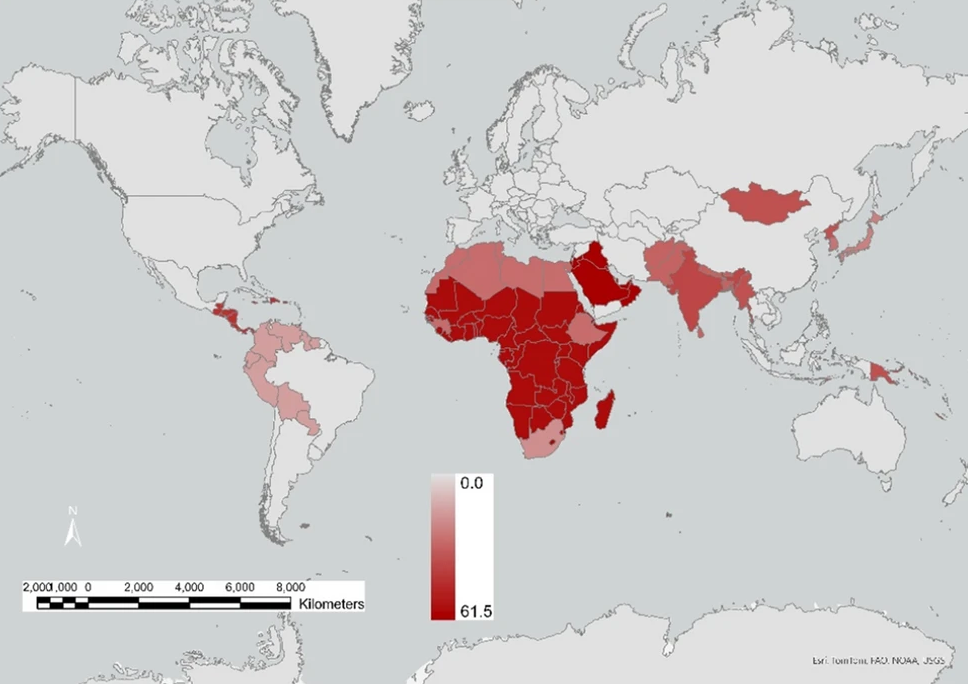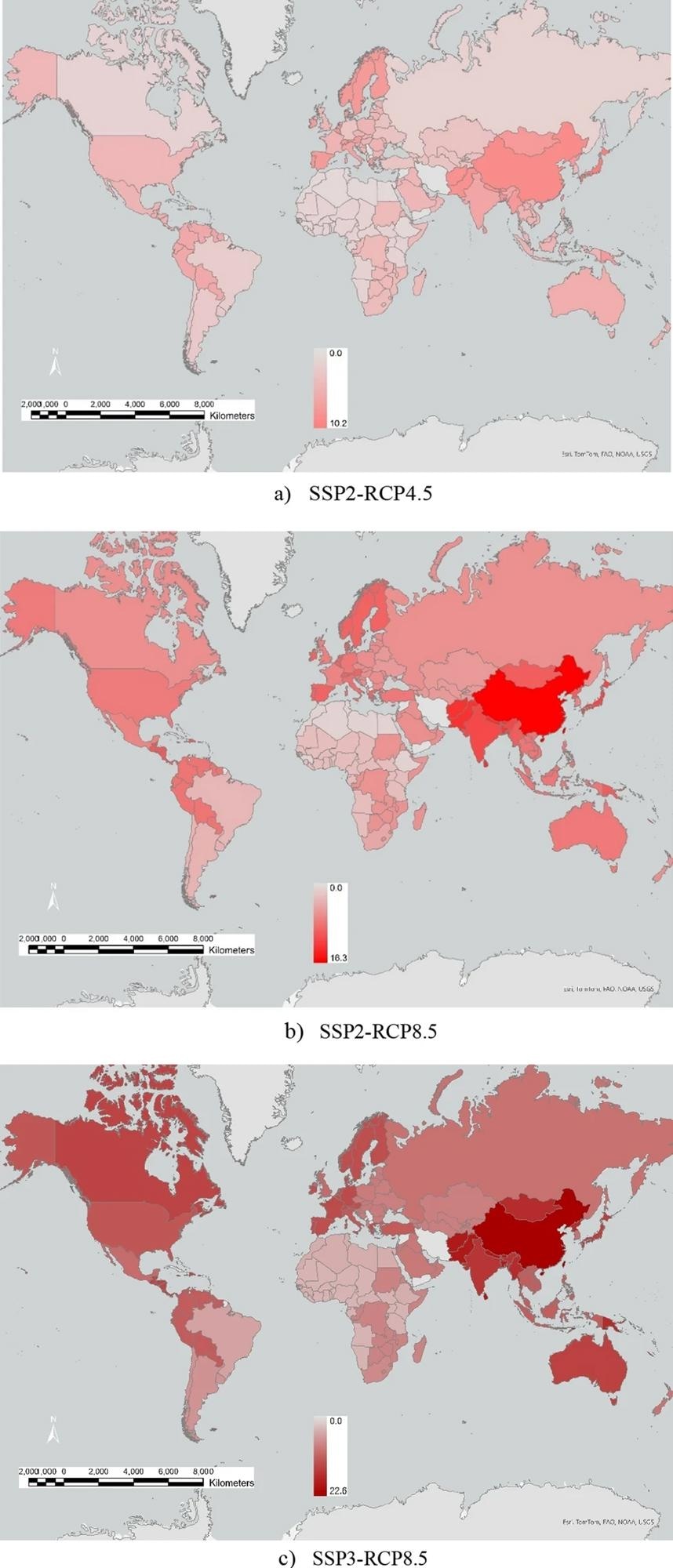Their results indicate that by 2050, food production worldwide could decline by up to 14%, with an increase of up to 1.36 billion people experiencing severe levels of food insecurity, highlighting the critical need for addressing water and heat stress in climate change policies.

Persons with severe food insecurity by region in 2050 relative to 2020 (% population range). Model output; maps generated using ArcGIS Pro 3.3 (https://www.esri.com). Study: Global impacts of heat and water stress on food production and severe food insecurity.
Background
Previous studies have established that climate change poses significant threats to the global food production system, which is highly reliant on ecosystems and water resources. These threats include disruptions in the water cycle, such as extreme climatic events and groundwater depletion, impacting regions differently.
Critical risks identified include water and heat stress on food production worldwide, exacerbated by increased water extraction for various sectors, particularly irrigated agriculture. Integrated assessment models (IAMs) have highlighted increased food insecurity due to population growth, dietary changes, and agricultural efficiencies, especially under regional rivalry and inequality scenarios, two shared socioeconomic pathways (SSPs).
Additionally, mitigation efforts to reduce emissions often lead to higher production costs and food prices, particularly affecting low-income regions. However, these IAMs lack detailed transparency on damage functions and temporal dynamics, necessitating more comprehensive models to assess global food security's intricate interdependencies.
About the study
The researchers used an intertemporal Computable General Equilibrium (CGE) model to project climate change's impacts on global food production and food security by 2050. Unlike many IAMs, this model integrates agricultural dynamics, like changes to irrigation and climate change damages, explicitly in the model.
This approach allows researchers to simulate feedback simultaneously across multiple steps. The model accounts for international trade, dynamic changes to water resources, and water availability for agricultural production. It also includes factors like heat stress that impact labor productivity.
The study utilized demographic data from SSP scenarios, namely SSP2 (a situation where current social, economic, and technological trends continue without significant deviations) and SSP3 (regional conflicts, nationalism, and other barriers to cooperation and trade dominate).
It also integrated two representative concentration pathways (RCPs) from RCP4.5 (under which greenhouse gas emissions stabilize by mid-century and then decline) and RCP8.5 (a high-emission scenario that assumes that greenhouse gas emissions continue to increase throughout the 21st century).
The model then generated three projections: SSP3-RCP8.5, SSP2-RCP4.5, and SSP2-RCP8.5.
These projections quantified the effects of heat and heat stress on agricultural commodities and estimated the number of additional people facing severe food insecurity by 2050, using data aggregated from 141 countries into 30 regions and 30 commodity sectors.
Projections were based on Giga calories (GCal) measurements of food production and quantified food insecurity using the Food Insecurity Experience Scale.
Findings
The study projected the impacts of climate change on global food production and food security under three scenarios: SSP2-RCP4.5, SSP2-RCP8.5, and SSP3-RCP8.5. The results indicated that 2050 worldwide food production could decrease by 6%, 10%, and 14%, respectively.
These reductions in food production were measured in GCal, reflecting significant declines in nutritional energy supply. Specifically, worldwide food production may fall from 9.75 million GCal in 2020 to 9.2, 8.8, and 8.4 million GCal under the three scenarios, respectively.
The declines vary regionally, with notable reductions in Africa, Australia, and some regions of South America. For instance, under SSP3-RCP8.5, food production could drop by up to 19.4% in Central America and 22.4% in China.
The number of individuals facing severe levels of food insecurity is expected to rise substantially, with increases of 556 million, 935 million, and 1.36 billion under SSP2-RCP4.5, SSP2-RCP8.5, and SSP3-RCP8.5, respectively.
Africa is particularly threatened by significant food production declines and population growth. The projections also suggest substantial increases in food prices and a shift in trade flows, with net food exporters like China becoming food importers by 2050, leading to increased imports from less water-stressed regions.

Regional food production reduction from irrigated agriculture due to heat stress and water stress in 2050 relative 2020 (% ranges). Model output; maps generated using ArcGIS Pro 3.3
Conclusions
The study concludes that heat and water stress significantly impact global food production and food security, projecting substantial declines in food production and surges in severe food insecurity by 2050.
Unlike previous studies, this research quantifies these impacts with a detailed focus on irrigation, commodity prices, resource allocation, and trade effects. The model highlights that climate change exacerbates existing vulnerabilities in food systems, with severe regional disparities.
Strengths of the study include its comprehensive integration of heat and water stress factors and its forward-looking approach that considers global trade dynamics. However, it has limitations, such as focusing only on blue water (irrigation) sources and not accounting for rainfed croplands' water stress impacts.
Future research should expand to include the impacts of green water (rainfed) and further investigate technological advancements and policy interventions to mitigate these effects.
The study underscores the urgent need to transform food systems to enhance resilience against climate change, reduce greenhouse gas emissions, and manage water resources sustainably.